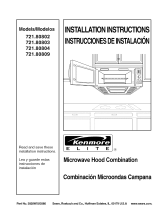
PASO 5: INSTALAR
LA PLACA DE MONTAJE EN LA PARED
EL HORNO DEBE ESTAR FIJADO
POR LO MENOS A UN POSTE DEL
ENTRAMADO DE LA PARED.
1. Trace una linea vertical sobre la pared en el
medic del espacio de 30" de ancho.
Use la placa de montaje como plantilla para la
pared posterior. Coloque la placa de montaje
sobre la pared asegurandose que las aletas
queden contra la parte inferior del gabinete.
Alinee la ranura y la linea central sobre la placa
de montaje sobre la pared.
2. Mientras sostiene la placa de montaje con una
mano, marque circulos sobre la pared en los
agujeros "A", "B", "C" y "D". Deben usarse 4
agujeros para el montaje. Si no se usan estos
agujeros, la instalaci6n puede no ser segura, por
Io que el instalador debe usar todos ellos para
una instalaci6n correcta. Use pernos de palancas
acodadas a trav_s de estos agujeros a menos
que uric de ellos este alineado con un poste del
entramado. En ese caso use un tornillo para
madera. Vea la Figura 26.
NOTA: Trace un quinto circulo dentro del Area
"E", a trav_s de uno de los agujeros de
abajo para ajustarse a la ubicaci6n de un
poste del entramado.
Para hornos ventilados atrav_s de la pared: el horno
necesita un agujero cortado en la pared posterior
para el conducto y para el adaptador de expulsi6n
que debe ser agregado a la placa de montaje. Vea
en la pr6xima pagina c6mo preparar el agujero de la
pared posterior y el adaptador expulsor/placa de
montaje para ventilaci6n por la pared.
3. Taladre hoyos a trav _s de los c irculos. Si
encuentra un poste del entramado, perfore un
agujero de 3/16" para un tornillo de fijaci6n. Si no
encuentra el entramado, perfore un agujero de
3/4" para los pernos de fiador. Deben usarse dos
o, preferiblemente, cuatro tornillos en los hoyos
"A" y "C" o "B" y "D" de cabeza cuadrada para
madera para fijar la placa de montaje de pared.
Asegt_rese de usar al menos 1 tornillo revestido
en los hoyos de la Area "E" en un husillo, y
coloque 4 tornillos articulados en los hoyos "A',
"B", "C" y "D" en la pared constru ido de piedras
encajadas sin mezcla cohesive o en el parche.
4. Fije la placa a la pared. Para usar los pernos con
cabeza del fiador: Quite las cabezas con los
fiadores. Inserte los pernos en la placa de
montaje y vuelva a colocar las cabezas con los
fiadores luego de pasar los pernos por los
agujeros de 3/4". Inserte las cabezas con fiadores
en la pared para montar la m_nsula. Puede tirar
hacia delante la mensula para ayudar a ajustar
los fiadores. Ajuste todos los pernos. Vea la Figura 27.
Agujeros de 3/16", sobre los tacos
Agujeros de 3/4", solamente sobre la mamposterfa
Unminimode
66 desdee p so
!
I II Solopar'a
III v:ntill:C_:n:d
'4'
Trace una linea _ _
sobre los postes_ '
delentramado _ \I
I t I
* Placademontaje _ Trace _ '
unalinea central _ \
_0_° I _
kinea central _
t ' [] ' t
PestaSade soporte Pesta_a de soporte
Figura 26
Jl_ Mas espacio que el espesor
de la pared
Alas del fiador
Placa de Perno del
montaje fiador
Pared
Figura 27
Extremo
del perno
33
m
Z!
O
I-






































